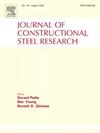Flexural behaviours of concrete-filled circular steel tubes at cold-region low temperatures
IF 4
2区 工程技术
Q1 CONSTRUCTION & BUILDING TECHNOLOGY
引用次数: 0
Abstract
This study investigated the flexural behaviours of concrete-filled steel tubes (CFSTs) employed in cold-region engineering structures. Firstly, two-point loading tests were conducted on seven circular CFSTs and two square CFSTs to investigate their flexural bending behaviours. The studied parameters included low temperature levels (T = 20°C, −30°C, −60°C, −80°C) and cross section types. It indicated that all CFSTs at low temperatures exhibited flexural failure with characteristics of vertical smeared cracks in concrete core and flexure large deformations (defection/span ratio ≥ 6.5%). Low temperatures did not influence the flexural failure mode of CFSTs. The load-deflection curves of CFSTs exhibit a ductile manner with three working stages. Reducing T from 20 to −30, −60, and −80°C resulted in an average increase on the ultimate bending resistance (or initial stiffness) of CFSTs 8.5% (16.5%), 15.4% (23.4%), and 26.5% (32.7%), respectively. Moreover, with the same cross-section area and steel content, square CFSTs exhibited higher bending resistance and initial resistance than circular CFSTs. AISC 360 and Eurocode 4 were checked to estimate the flexural resistance (Mu) and initial stiffness (K0) of circular CFSTs at low temperatures. Moreover, theoretical models were formulated to forecast Mu and K0 values for circular CFSTs at low temperatures.
求助全文
约1分钟内获得全文
求助全文
来源期刊

Journal of Constructional Steel Research
工程技术-工程:土木
CiteScore
7.90
自引率
19.50%
发文量
550
审稿时长
46 days
期刊介绍:
The Journal of Constructional Steel Research provides an international forum for the presentation and discussion of the latest developments in structural steel research and their applications. It is aimed not only at researchers but also at those likely to be most affected by research results, i.e. designers and fabricators. Original papers of a high standard dealing with all aspects of steel research including theoretical and experimental research on elements, assemblages, connection and material properties are considered for publication.
 求助内容:
求助内容: 应助结果提醒方式:
应助结果提醒方式:


